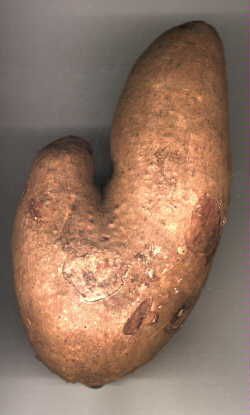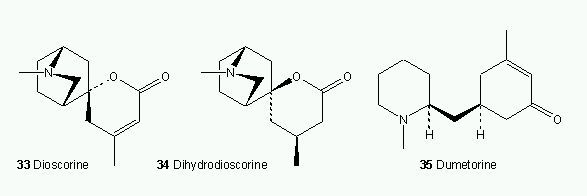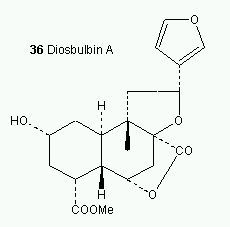|
|||||
|
|||||||
|
    An initiative of :Stichting Food-Info
|
| Food-Info.net> Food Products > Tropical roots and tubers YamsThe world production of yam was estimated at 28.1 million tonnes in 1993. Out of this production, 96% came from West Africa, the main producers being Nigeria with 71% of world production; Côte d'Ivoire 8.1%; Benin 4.3% and Ghana 3.5% In the humid tropical countries of West Africa, yams are one of the most highly regarded food products and are closely integrated into the social, cultural, economic and religious aspects of life. Traditional ceremonies still accompany yam production, indicating the high status given to the plant. 
The genus Dioscorea contains a wide range of species used as food, of which about five or six species are widely used. There are many varieties of yam species widespread throughout the humid tropics, but the edible yams are derived mainly from about ten. The most economically important species are: White yam (Dioscorea rotundata Poir). Originated in Africa and is the most widely grown and preferred yam species. The tuber is roughly cylindrical in shape, the skin is smooth and brown and the flesh usually white and firm. A large number of white yam cultivars exist with differences in their production and post-harvest characteristics. Yellow yam (Dioscorea cayenensis Lam.). Derives its common name from its yellow flesh, which is caused by the presence of carotenoids. It is also native to West Africa and very similar to the white yam in appearance. Apart from some morphological differences (the tuber skin is firm and less extensively grooved), the yellow yam has a longer period of vegetation and a shorter dormancy than white yam. Water yam (Dioscorea alata L.). Originates from South East Asia; it is the species most widely spread throughout the world and in Africa is second only to white yam in popularity. The tuber shape is generally cylindrical, but can be extremely variable. Tuber flesh is white and "watery" in texture. Bitter yam (Dioscorea dumetorum). Also called trifoliate yam because of its leaves. Originates in Africa where wild cultivars also exist. One marked characteristic of the bitter yam is the bitter flavour of its tubers. Another undesired characteristic is that the flesh hardens if not cooked soon after harvest. Some wild cultivars are highly poisonous. Agronomic CharacteristicsYam is grown and cultivated for its energy-rich tuber. It is adaptable to fairly fertile soils and is suitable for intercropping with grain legumes such as cowpeas, soybeans and a variety of leafy vegetables. A well-drained, rich, loamy soil however is the most favourable. Yam requires a warm, humid climate; however, the crop possesses considerable drought resistance. It gives more calories per unit of land area than most crops and matures within seven months. On soils of average fertility, between 20 and 30 tonnes per hectare of tubers can be obtained, and up to 55 tonnes per hectare on fertile soils; it also stores very well. It has quite demanding labour and maintenance requirements, such as hilling the soil around each plant to form mounds, to ensure a pulverised soil favourable for tuber development. Storage of tubers occurs after harvest in barns or heaps covered with grass. Antinutritional FactorsThe edible, mature, cultivated yam does not contain any toxic principles. However, bitter principles tend to accumulate in immature tuber tissues of D. rotundata and D. cayenensis. They may be polyphenols or tannin-like compounds. Wild forms of D. dumetorum do contain bitter principles, and hence are referred to as bitter yam. The bitter principle has been identified as the alkaloid dihydrodioscorine, while that of the Malayan species, D. hispida, is dioscorine. These are water-soluble alkaloids, which, on ingestion, produce severe and distressing symptoms. Severe cases of alkaloid intoxication may prove fatal. There is no report of alkaloids in cultivated varieties of D. dumetorum.  Source The bitter principles of D. bulbifera (called the aerial or potato yam) include a 3-furanoside norditerpene called diosbulbin. These substances are toxic, causing paralysis. Extracts are sometimes used in fishing to immobilise the fish and thus facilitate capture. Toxicity may also be due to saponins in the extract. Zulus use this yam as bait for monkeys, and hunters in Malaysia use it to poison tigers. In Indonesia an extract of D. bulbifera is used in the preparation of arrow poison.  Source Utilisation and ProcessingBy far the greater part of the world's yam crop is consumed fresh. Tuber utilisation is mostly as boiled or pounded yam. For use in fresh form, tubers are stored between harvests. The use of yam tubers has been in home food with little industrial involvement. Changes in wholesomeness during storage include wound repair, diseases and pests of stored tubers; hence yam tubers are lost after 4-5 months of storage. Drying of (injured) tubers soon after harvest and converting into slices or milling into flour for fufu ensures availability of yam in various forms. Traditionally processed yam products are made in most yam-growing areas, usually as a way of utilising tubers that are not fit for storage Usually fresh yam is peeled, boiled and pounded until a sticky elastic dough is produced. This is called pounded yam or yam fufu. The only processed yam product traditionally made at village level is yam flour. Except by the Yoruba people in Nigeria, yam flour is regarded as an inferior substitute for freshly pounded yam because it is often made from damaged tubers. Yam flour is favoured in the Yoruba area where the reconstituted food is known as amala . To a limited extent, yam flour is also manufactured in Ghana where it is known as kokonte . The nutritional value of yam flour is the same as that of pounded yam. Yam flour: The tubers are sliced to a thickness of about 10 mm, more or less, depending on the dryness of the weather. The slices are then parboiled and allowed to cool in the cooking water. The parboiled slices are peeled and dried in the sun to reduce the moisture content. The dried slices are then ground to flour in a wooden mortar and repeatedly sieved to produce a uniform texture. Today, small, hand-operated or engine-driven corn mills or flourmills are increasingly used. Treatment with sodium bisulphate is often used to prevent phenolic oxidation during drying which darkens the colour of the product (especially with white guinea yam, D. rotundata). Blanching in place of sodium bisulphate achieves similar results. The yam flour is rehydrated and reconstituted into fufu and eaten with a soup containing fish, meat and/or vegetables Bitter yams are not normally eaten except at times of food scarcity. They are usually detoxified by soaking in a vessel of salt water, in cold or hot fresh water or in a stream. In Asia, detoxification methods, involving water extraction, fermentation and roasting of the grated tuber are used for bitter cultivars of D. bulbifera. Industrial processing of yamYams have not been processed to any significant extent commercially. Dehydrated yam flours and yam flakes have been produced by sun drying. The manufacture of fried products from D. alata has also been attempted recently. Both chips and French fries have been manufactured. Preservation of yam in brine has been attempted, but with little success. Since pounded yam has so much prestige and is the most popular way of eating yam, two attempts have been made to commercialise the process. The first was the production of dehydrated pounded yam by drum drying. This product could then be reconstituted without further processing. This production was first attempted in Côte d'Ivoire in the mid-1960s, under the trade name "Foutoupret", by air-drying precooked, grated or mashed yam. Attempts to manufacture fried yam chips, similar to French fried potatoes have been reported from Puerto Rico. |
|
| ||
| Food-Info.net is an initiative of Stichting Food-Info, The Netherlands | ||||||